Ai Terminology 2026: 50+ Key Concepts Every Business Must Know

In the rapidly advancing era of AI, many businesses face barriers from the very beginning due to a lack of foundational knowledge. Mastering AI terminology enables all departments within an organization to communicate consistently and accelerate AI strategy execution. This MOR Software's article provides a comprehensive list of essential terms to help your business maintain a competitive edge in the era of AI.
What Is AI Terminology?
AI Terminology refers to the collection of concepts, definitions, and specialized vocabulary used to describe the field of artificial intelligence. It serves as an essential foundation for individuals and businesses to understand how machine learning works.

When integrating AI into business operations, mastering AI terminology enables technical teams, managers, and employees to communicate using a unified “AI language.” For this reason, many organizations create an AI terminology glossary to standardize definitions, ensure accuracy in technical discussions, and streamline AI implementation strategies.
Top 50+ AI Terminology You Should Know Before 2026
To keep up with the rapid pace of technological advancement, mastering the AI terminology glossary is essential for both individuals and businesses. The following list of AI terms to know includes more than 50 key concepts that will help you gain a deeper understanding of artificial intelligence technologies.
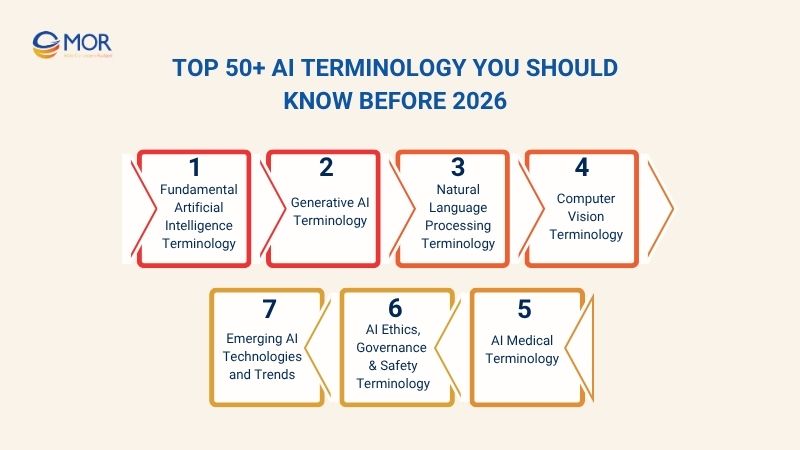
Fundamental Artificial Intelligence Terminology
The fundamental artificial intelligence terminology forms the foundation of every artificial intelligence glossary. Understanding these core terms helps individuals and organizations navigate the fast-evolving AI landscape more effectively. Below are the key concepts you should know.
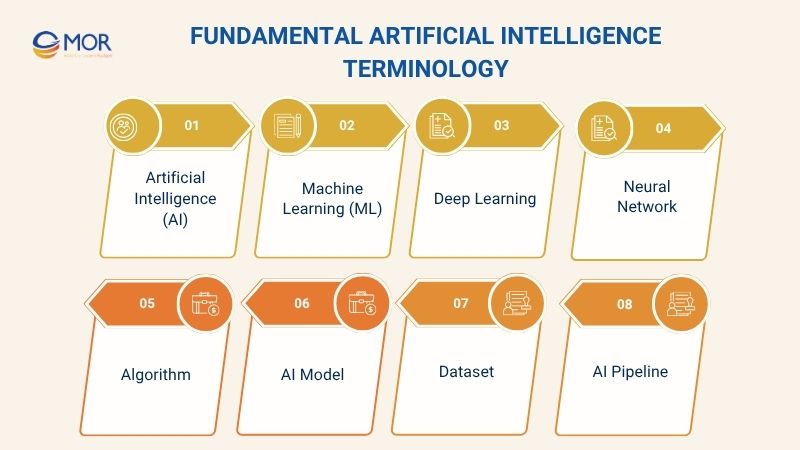
- Artificial Intelligence (AI): A branch of computer science focused on creating machines that can perform tasks requiring human-like intelligence. This includes reasoning, problem-solving, understanding natural language, and adapting to new information.
- Machine Learning (ML): A core subset of AI that enables machines to learn from data without explicit programming. Machine learning systems improve performance over time by identifying patterns and making predictions based on experience.
- Deep Learning: An advanced subset of machine learning that uses multi-layered neural networks to process large and complex datasets. Deep learning powers technologies such as facial recognition, autonomous driving, and advanced natural language models.
- Neural Network: A computational structure inspired by the human brain, consisting of nodes (neurons) connected in layers. Neural networks are used in tasks like image classification, speech recognition, and anomaly detection.
- Algorithm: A defined set of steps or rules that an AI system follows to process data and produce results. Machine learning algorithms form the logic behind every AI model, influencing how efficiently it operates.
- AI Model: A trained system created from algorithms and data that can process inputs to deliver outputs such as predictions, classifications, or recommendations. AI models are central to applications like chatbots, fraud detection, and recommendation engines.
- Dataset: A collection of data structured, semi-structured, or unstructured, used for training, validating, and testing AI models. High-quality datasets are essential for producing accurate AI results.
- AI Pipeline: The complete workflow of developing AI solutions, from data preparation and model training to deployment and ongoing optimization. A well-structured pipeline ensures scalability and consistent performance of AI systems.
Generative AI Terminology
In the debate of terminology, Generative AI vs. AI, it’s essential to understand that Generative AI focuses on creating new content, while traditional AI often focuses on analysis, prediction, or automation. This section of the AI terminology glossary outlines the most important Generative AI terms you should know.
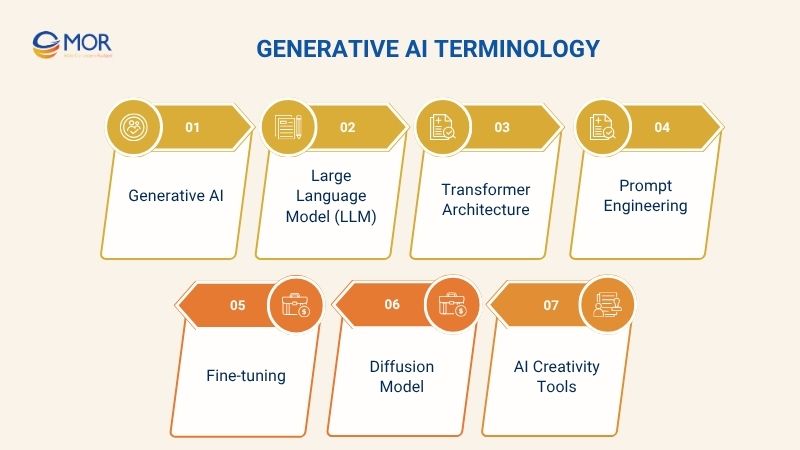
- Generative AI: A type of AI automation that can create new data, such as text, images, audio, or video, based on patterns learned from existing data. Popular examples include ChatGPT, DALL·E, and Midjourney.
- Large Language Model (LLM): A massive AI model trained on vast amounts of text data to understand and generate human-like language. LLMs power advanced chatbots, translation tools, and content generation platforms.
- Transformer Architecture: A neural network architecture that revolutionized natural language processing and Generative AI by enabling models to process large text sequences efficiently. It’s the foundation of LLMs like GPT and BERT.
- Prompt Engineering: The process of designing and refining input prompts to guide Generative AI models in producing accurate, relevant, and high-quality outputs.
- Fine-tuning: The technique of training a pre-trained AI model on specific datasets to adapt it to specialized tasks or industries, improving accuracy and relevance.
- Diffusion Model: A generative approach used primarily for creating high-quality images by iteratively refining random noise into detailed visuals. Tools like Stable Diffusion are based on this model.
- AI Creativity Tools: Applications powered by Generative AI that assist in creative tasks such as graphic design, content writing, music composition, and video production.
Natural Language Processing (NLP) Terminology
Within the AI terminology glossary, Natural Language Processing (NLP) plays a crucial role in enabling machines to understand, interpret, and respond to human language. Mastering these AI terms will help you better understand how language-based AI systems work.

- Natural Language Processing (NLP): A branch of artificial intelligence that focuses on the interaction between computers and human languages, allowing systems to process, analyze, and generate text or speech.
- Named Entity Recognition (NER): An NLP technique used to identify and categorize entities in text, such as names of people, organizations, locations, dates, and numerical values.
- Sentiment Analysis: A process that uses NLP and machine learning to determine the sentiment behind a piece of text, whether it is positive, negative, or neutral.
- Chatbot AI: An AI application that uses NLP and machine learning to simulate human conversation, often used in customer service, virtual assistants, and interactive platforms.
- Text-to-Speech (TTS): A technology that converts written text into natural-sounding speech, enhancing accessibility and user experience.
- Speech-to-Text (STT): A technology that converts spoken language into written text, commonly used in transcription, voice commands, and virtual assistants.
- AI Word Embedding: A representation of words as numerical vectors that capture semantic meaning, enabling machine learning models to understand context and relationships between words.
Computer Vision Terminology
In the AI terminology glossary, Computer Vision is a vital field of artificial intelligence that empowers machines to interpret and analyze visual information. Understanding these AI terms ensures a strong grasp of how visual AI systems operate.

- Computer Vision: A field of artificial intelligence that focuses on enabling machines to process and interpret images, videos, and real-world visual data. It supports diverse applications such as autonomous driving, medical diagnostics, and security surveillance.
- Object Detection: A computer vision technique that identifies and locates multiple objects within an image or video frame. It is commonly used in autonomous vehicles, retail analytics, and safety monitoring.
- Image Segmentation: A process that divides an image into regions to simplify object recognition and analysis. This technique improves accuracy in applications like medical imaging, agriculture, and industrial inspection.
- Facial Recognition AI: An AI system that analyzes unique facial features to identify or verify individuals. It is widely implemented in security systems, identity authentication, and personalized customer experiences.
- Optical Character Recognition (OCR): A technology that extracts text from printed or handwritten documents and converts it into machine-readable formats. This process is essential for document digitization, automation, and data retrieval.
- Video Analysis AI: A branch of computer vision that processes video data to detect objects, track movements, and interpret events. It is applied in traffic monitoring, sports analytics, and real-time security surveillance.
- Image Classification: A computer vision method that assigns images to predefined categories using trained AI models. It is frequently used in medical diagnostics, product categorization, and environmental monitoring.
AI Medical Terminology
In the AI terminology glossary, AI medical terminology refers to concepts and technologies applying artificial intelligence in healthcare. These AI terms to know help medical professionals and organizations understand how AI supports diagnosis, treatment, and decision-making.
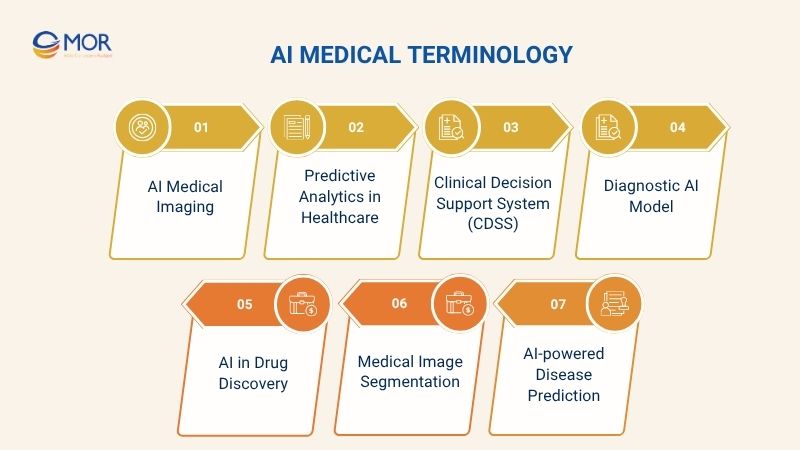
- AI Medical Imaging: A field of medical terminology that uses artificial intelligence to enhance the analysis of medical scans such as X-rays, MRIs, and CT images. It improves diagnostic accuracy, speeds up analysis, and reduces human error.
- Predictive Analytics in Healthcare: The application of AI models to forecast patient outcomes, disease risks, or treatment responses. This capability allows healthcare providers to create proactive care plans and optimize resource allocation.
- Clinical Decision Support System (CDSS): An AI-powered tool that assists clinicians by providing evidence-based recommendations and alerts. CDSS improves diagnostic accuracy, enhances treatment planning, and supports personalized care.
- Diagnostic AI Model: An artificial intelligence system designed to identify diseases or medical conditions from patient data, medical images, or lab results. These models help reduce diagnostic time and increase accuracy.
- AI in Drug Discovery: The use of AI algorithms to analyze chemical data, predict molecular interactions, and accelerate drug development. This technology shortens research timelines and reduces the cost of bringing new medicines to market.
- Medical Image Segmentation: A computer vision technique in AI medical terminology that divides medical images into meaningful segments. It is essential for detecting tumors, measuring organ size, and preparing surgical plans.
- AI-powered Disease Prediction: The application of AI models to forecast the likelihood of disease occurrence or progression. It enables preventive measures, early interventions, and more efficient healthcare strategies.
>>> Click here to explore History of AI and update more knowledge!
AI Ethics, Governance & Safety Terminology
In the AI terminology glossary, ethics, governance, and safety are critical areas ensuring AI is developed and deployed responsibly. These AI terms to know help organizations build trust, comply with regulations, and minimize risks in AI adoption.
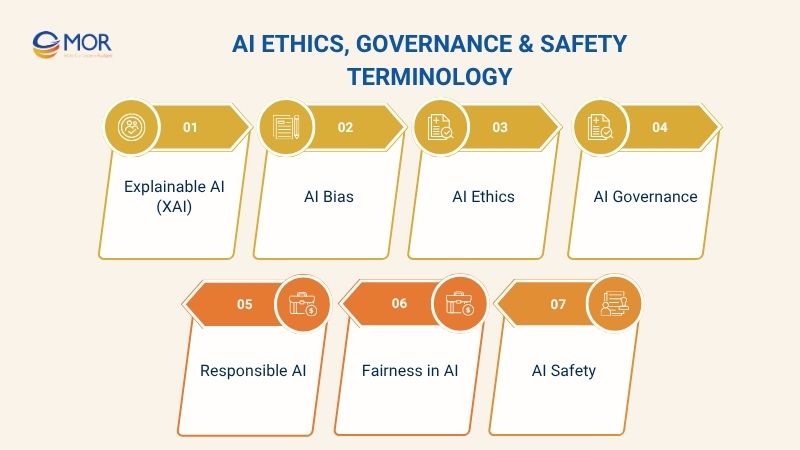
- Explainable AI (XAI): An approach in artificial intelligence that makes AI decision-making processes transparent and understandable. XAI helps stakeholders trust AI outputs by clarifying how predictions and recommendations are generated.
- AI Bias: The presence of unfair or prejudiced outcomes in AI systems due to biased training data or flawed model design. Addressing AI bias is essential to ensure fairness, accuracy, and compliance in AI applications.
- AI Ethics: A set of principles guiding the responsible development and use of artificial intelligence. AI ethics focuses on fairness, accountability, privacy, and minimizing harm.
- AI Governance: The framework of policies, rules, and oversight mechanisms that guide the responsible use of AI within organizations. Effective AI governance ensures compliance, ethical standards, and risk management.
- Responsible AI: A principle in the AI terminology glossary that emphasizes developing AI systems that are ethical, transparent, and beneficial to society. Responsible AI supports trust and sustainable innovation.
- Fairness in AI: A concept ensuring AI models provide equitable outcomes across diverse user groups. It focuses on removing bias, validating datasets, and ensuring inclusive results.
- AI Safety: A discipline dedicated to preventing AI systems from causing unintended harm or malfunctioning. AI safety research ensures reliable, predictable, and controlled AI behavior.
Emerging AI Technologies and Trends
In the AI terminology glossary, emerging AI technologies represent the next wave of innovation, shaping how artificial intelligence integrates into industries and daily life. Understanding these AI terms helps individuals and businesses stay ahead of upcoming advancements.
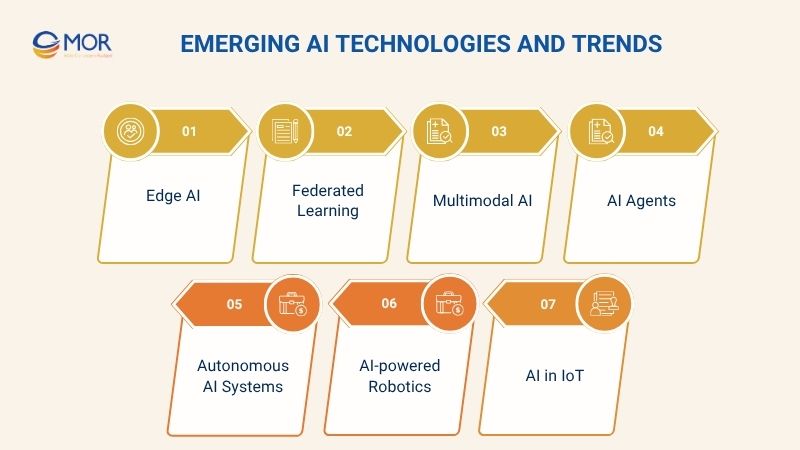
- Edge AI: A deployment method where AI models run directly on local devices instead of cloud servers. This approach reduces latency, improves privacy, and supports real-time decision-making in applications like autonomous vehicles and smart sensors.
- Federated Learning: A machine learning technique that trains AI models across multiple decentralized devices without sharing raw data. It enhances privacy, security, and compliance in sensitive industries such as healthcare and finance.
- Multimodal AI: An advanced AI capability that processes and integrates multiple types of data, such as text, images, and audio. It powers applications like intelligent assistants, creative AI diversity, and adaptive learning systems.
- AI Agents: Autonomous AI-powered programs that perform specific tasks or make decisions on behalf of users. AI agents are increasingly used in customer service, process automation, and dynamic decision-making systems.
- Autonomous AI Systems: AI-driven systems capable of performing complex tasks with minimal human intervention. These systems are key to innovations in self-driving cars, industrial automation, and intelligent drones.
- AI-powered Robotics: Robotics systems enhanced by AI to improve decision-making, adaptability, and precision. These robots are widely used in manufacturing, logistics, and healthcare.
- AI in IoT: The integration of artificial intelligence into Internet of Things (IoT) ecosystems to analyze sensor data and optimize device operations. This combination enables predictive maintenance, smart homes, and intelligent infrastructure.
Is Your Business Ready For The Next Wave Of The AI Era?
The AI wave is experiencing unprecedented growth. According to a Demand Sage report (April 2025), around 40% of businesses worldwide have already adopted AI in their operations, with another 42% exploring or developing AI deployment plans. This means more than 82% of organizations are engaging with AI at some level.
To avoid falling behind, businesses need to prepare from foundational knowledge to comprehensive implementation strategies. One essential step is equipping teams with a solid understanding of the AI terminology glossary. This ensures every member of the organization can communicate in a unified language when working with artificial intelligence technologies.
Beyond knowledge, companies should proactively integrate AI solutions into business operations. These applications extend to advanced areas such as AI in IoT, AI-powered robotics, and predictive analytics in healthcare (particularly for medical organizations).
In Conclusion
The ability to understand and accurately apply AI terminology will determine the level of success for any business. MOR Software is ready to accompany your organization in building a smarter future and optimizing AI integration in business operations. Contact our team of experts for tailored AI solutions that will help your business achieve sustainable growth in the digital era.
MOR SOFTWARE
Frequently Asked Questions (FAQs)
Who is the father of AI?
Often referred to as the "father of AI," John McCarthy (1927–2011) was a pioneer in both computer science and artificial intelligence. His research significantly shaped the direction of AI development over several decades.
What are the AI terminologies?
AI terminologies are key terms and concepts used to describe artificial intelligence technologies, such as machine learning, deep learning, NLP, and generative AI.
What are the 7 C's of AI?
The 7 C’s of AI are: Cognition, Computation, Communication, Collaboration, Creativity, Critical thinking, and Context awareness.
What are the 5 pillars of AI?
The 5 pillars of AI are: Machine Learning, Natural Language Processing, Computer Vision, Robotics, and Expert Systems.
What are the 4 Ps of AI?
The 4 Ps of AI are: Perception, Processing, Prediction, and Personalization.
Rate this article
0
over 5.0 based on 0 reviews
Your rating on this news:
Name
*Email
*Write your comment
*Send your comment
1